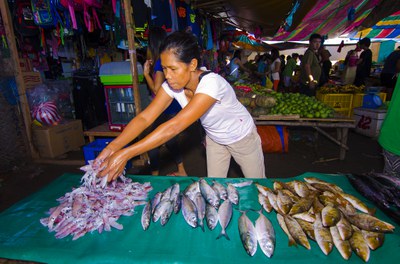Women Marine Guards Protect the Underwater “Treasure”

In the past, the nearby Subic Bay was a site of an important Spanish naval base. Now, historic shipwrecks - remnants of that time - and coral reefs teeming with fish form a spectacular dive site just a stone’s throw from the beach. Despite the influx of visitors pouring in by boats from the port of Matnog, the shore remains pristine and rich with marine life, largely thanks to a group of local women taking charge of protecting the environment and fish.
“It’s very important among us locals to protect the sea because this is our treasure,” said Natividad Francisco, a member of Calintaan Women Organization in Matnog. “When we grow old, this is the same treasure we will bequeath to our children.”
Since 2013, the members of this all-women community organization have been acting as volunteer Marine Protected Area Guards. With the assistance of USAID’s Ecosystems Improved for Sustainable Fisheries (ECOFISH) and the Philippines’ Department of Agriculture’s Bureau of Fisheries and Aquatic Resources, they have been transforming Subic Beach from an illegal fishing ground into an eco-tourism site. Having witnessed the negative effects of illegal fishing in their waters, local women decided to take action, monitoring fishing and ensuring their underwater “treasure” is protected.
Subic Beach used to be a fishing ground open for local fishers and outsiders from other islands. With no existing conservation efforts before the 2000s, illegal fishing and overfishing went unabated, damaging precious habitats of fish and other marine species – a phenomenon that continues to threaten marine biodiversity, and ultimately fishers’ livelihoods, in many parts of the Philippines.
“In the past, people didn’t value Subic Beach. There was dynamite fishing here. That was before it became a sanctuary,” said Natividad Francisco.

To support this transformation, in 2012-2017, USAID through ECOFISH partnered with the Philippines Department of Agriculture’s Bureau of Fisheries and Aquatic Resources and local governments to improve fisheries management and support local economies in eight Marine Key Biodiversity Areas in the Philippines, including in Calintaan Island. Hand in hand with local governments and organizations, ECOFISH taught fishing communities how much to fish, where to fish and how to monitor fish in order to manage their wild fish resources sustainably and protect fishers’ livelihoods for the long run.
In Matnog, ECOFISH taught local women, including women’s volunteer marine guards, new skills to generate income from ecotourism brought about by the improved condition of the marine environment. They learned crafts-making and fish trading, in addition to their traditional income sources, such as drying fish. Together with men, they also received training on gender awareness, roles and needs - a basic requirement in all USAID’s ECOFISH activity sites.
As a result of their additional skills and resourcefulness, the women started enforcing rules in the marine protected area in innovative ways. While local men were patrolling in the sea, women working in the docking area were in charge of checking the type and number of fish that landed at the port and serving as informants of illegal fishing practices. Women trading fish in the community also kept an eye on dynamite explosions coming from the sea.

We protect fish from being caught and guard the area against fishermen because fishing is prohibited here. We also have to take care of the corals, so they grow well. That is where fish go and spawn,” stated Natividad Francisco.
Building on the work USAID had previously started under its Fisheries Improved for Sustainable Harvest (FISH) project, implemented in 2003-2010, by the completion of ECOFISH in 2017, communities saw a 24% increase in fish biomass - in other words, the number and size of the fish - and a 12% increase in economic benefits. Now fishers are earning more, saving more and eating more fish, while spending less time fishing. In addition, more than 1.8 million hectares of municipal marine waters, an area in size between that of Connecticut and New Jersey, are now better managed by local governments and communities.
For the Philippines, a nation of over 7,100 islands, the sea is a critical economic resource. However, it is estimated that 75 percent of the Philippine fishing grounds are overfished. USAID’s Ecosystems Improved for Sustainable Fisheries (ECOFISH) project worked together with the Philippines Department of Agriculture’s Bureau of Fisheries and Aquatic Resources and local governments to improve fisheries management in eight Marine Key Biodiversity Areas. The project also focused on developing a variety of market-based initiatives to improve economic opportunities for small-scale fishers. Over the course of five years, communities saw a 24 percent increase in fish biomass and a 12 percent increase in economic benefits. In total, ECOFISH helped improve management of more than 1.8 million hectares of the Philippines’ municipal marine waters.
Back on Subic Beach, the local women guards continue to protect the marine sanctuary with greater confidence and collaboration among themselves, and deeper respect from the community for their new-found leadership skills. With improved livelihood skills such as crafts and fish trading, the women are able to earn more for their families. Fishers, whose catch was winding down due to illegal fishing, now fish outside of the protected areas more sustainably, and as a result of the efforts to conserve fisheries and protect their habitats, their catch is more plentiful.
USAID continues to work on fisheries conservation in the Philippines and other countries through various projects, such the Harnessing Markets to Secure a Future for Near Shore Fishers, a partnership of USAID with Rare and Bloomberg Philanthropies. In 2015-2017, the project worked with Filipino communities to sustainably manage fisheries, including in the coastal town of Cortes which won the “Outstanding Coastal Community” award from the national government’s Bureau of Fisheries and Aquatic Resources. The program also initiated over 100 savings clubs to enable fishers and other residents of fishing communities to improve their financial literacy and save to improve their families’ economic well-being.


